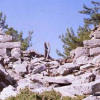
The archaic city of Stratonikeia lies in the borders of the Eskihisar Village on Yatağan - Milas highway that is 6 - 7 km to the west of Yatağan District of Muğla.
The city was established in the 3rd century B.C. The Syrian King Seleukos I, gave his wife Stratonike to his son Antiokhos. Antiokhos established a city in the name of Stratonike, who was first his step mother, and then his wife. According to Strabon, who was a traveler and a writer, the city was full of very beautiful buildings. From the coins obtained during the excavations, it is understood that Stratonikeia coins had been minted since the date of its gaining its independence from Rhodes in 167 B.C. and continued until the Gallienus period (253 - 268 AD).
The acropolis of the city is at the top of a mountain in the south. This top is surrounded with a wall. Ruins of a small temple constructed for the emperor can be seen on a terrace on the noth slope of the mountain, just below the highway of today.
There is a theatre below this temple. Here, a cavea is divided into 9 cuneusas with stairs, and there is a single diazoma. The remainders of the stage building have been exposed to a great extent as a result of the excavations. Above the archaic city, Eskihisar Village, which is left today, is present. The city is surrounded with walls and today, only unimportant projections of the city walls can be seen. The ruins of a strong fort made of cut stones and lime mortar lie in the northeastern corner of the settlement area. From the inscription stones and column bodies taken from other buildings, it is understood that the building was repaired.
The main entrance door in the north of the city consists of large blocks. It is made with wide and fine masonry. The ruins show that there was an arch on that door. The door has two entrances. There is a nymphaion between the two door entrances. Behind the door, an area with columns and a road are seen.
In the middle of the city, the most significant building, a bouleuterion, where the city assembly met, is located. A door standing alone in the west of this building is the entrance door of the area. This was claimed to have been the Serapis Temple; but the inscriptions found in the excavations have shown that this thought was wrong. On the northen external wall of the Bouleuterion, the price list of Diocletianus and the introduction part relating to the application of it are written in Latin. The seats of this building in the lower part are protected.
In the western part of the city, the building named a gymnasion, where the young people were trained in intellectual and physical aspects and trained sports in Ancient Greek and Rome, exists.
There are chamber graves at the side of the holy road in front of the entrance door of the city. The holy road starting from the entrance door passes through the necropolis and reaches to the Hekate holy area in Lagina. This necropolis area has disappeared today, remaining under a coal mine basin.
 The archaic city of Stratonikeia lies in the borders of the Eskihisar Village on Yatağan - Milas highway that is 6 - 7 km to the west of Yatağan District of Muğla.
The archaic city of Stratonikeia lies in the borders of the Eskihisar Village on Yatağan - Milas highway that is 6 - 7 km to the west of Yatağan District of Muğla.